SOUL BLADER
( Soul Blazer )
|
|
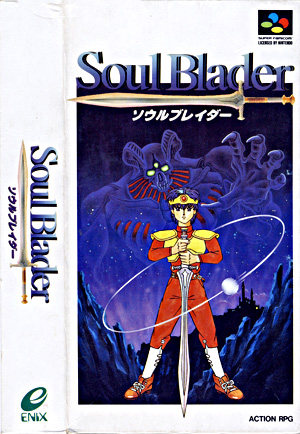
|

|
|
ソウルブレイダー
©1992 Quintet/Enix.
Release: 1992-01-31 (¥8800)
Cartridge SHVC-SO
Role Playing Game


|
Released in America as
SOUL BLAZER
( SNS-SO-USA )
|




|
Released in Europe as
SOUL BLAZER
( SNSP-SO-XXX )
|
|
Soul Blader is a role playing game by Quintet and published by
Enix. In a distant land known as the Freil empire, the greedy
King Maggrid captured the brilliant scientist Dr Leo and
forced him to build a machine capable of summoning demons from other
dimensions. This is when the dreadful Deathtoll was brought to
the world. The demon promised to give King Maggrid gold and
treasures in exchange of all the living souls in the world. Time passed
and Maggrid's greed decimated every single living life forms... from plants,
animals to humans. This is when our adventure starts, all souls on
Earth are in the hands of the evil Deathtoll and our hero,
sent by the gods, embarks on a long journey to save the world.
All the lost souls are now trapped inside seals guarded by all sorts of
demons and the player must release them as well as restore the
towns they used to inhabit. Each region starts completely barren
and our hero must defeat monsters and travel through uninviting
dungeons in order to release the buildings and villagers (and other
very unique characters) that once
thrived throughout the world. Our hero can also gain new weapons, armors,
magic spells and special items as he progresses through the game, most of
them unlocking new powers allowing him to move forward in his long journey.
Soul Blader consists of six large worlds and is single player only.
|
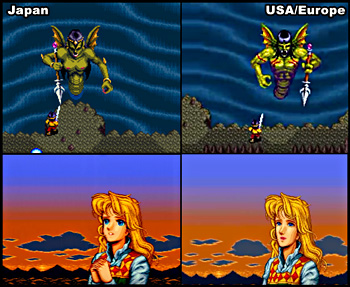 Although Soul Blader (the original Super Famicom version) and Soul Blazer (US
and European versions) look fairly identical, some odd and surprising differences can
be found. For instance, the game's title screen was edited and went from a blue color
scheme (Japan) to an orange color scheme (US and Europe). The
title change to Soul Blazer is an interesting one too! The
Japanese name is ソウルブレイダー, which is pronounced Souru Bureidā, so it
is anyone's guess as to why the western name was changed to Soul Blazer...
Additionally, in the Japanese instruction manual, the hero is sent by the God in the
Sky (天空の神)who was changed to the 'Master' in the US/European version (maybe using
a non-denominational name was more acceptable in the western release).
About the game itself, some boss encounters were surprisingly modified - in the first boss room, an additional
conveyor belt was added in the center of the screen making the whole fight arguably
more difficult. Additionally, the Medusa sprite was edited and although it
clearly appears as a female opponent in the Japanese version, he was turned into
a male in the US/European version. Finally, Lisa's graphics were modified in
the end credits - she has larger eyes in the Japanese version and she clearly holds her hands
together showing that she's praying for the player. This was entirely removed and modified in
the US/European version.
Although Soul Blader (the original Super Famicom version) and Soul Blazer (US
and European versions) look fairly identical, some odd and surprising differences can
be found. For instance, the game's title screen was edited and went from a blue color
scheme (Japan) to an orange color scheme (US and Europe). The
title change to Soul Blazer is an interesting one too! The
Japanese name is ソウルブレイダー, which is pronounced Souru Bureidā, so it
is anyone's guess as to why the western name was changed to Soul Blazer...
Additionally, in the Japanese instruction manual, the hero is sent by the God in the
Sky (天空の神)who was changed to the 'Master' in the US/European version (maybe using
a non-denominational name was more acceptable in the western release).
About the game itself, some boss encounters were surprisingly modified - in the first boss room, an additional
conveyor belt was added in the center of the screen making the whole fight arguably
more difficult. Additionally, the Medusa sprite was edited and although it
clearly appears as a female opponent in the Japanese version, he was turned into
a male in the US/European version. Finally, Lisa's graphics were modified in
the end credits - she has larger eyes in the Japanese version and she clearly holds her hands
together showing that she's praying for the player. This was entirely removed and modified in
the US/European version.
|
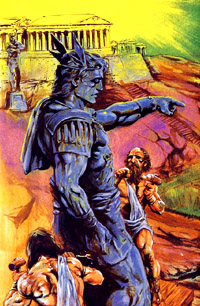 Soul Blader is often considered as the first opus of a trilogy released
by Quintet and Enix for the Super Famicom system, usually connecting
Soul Blader with Gaia Gensōki (aka Illusion of Gaia) and
Tenchi Sōzō (aka Terranigma). Although this is a logically valid statement,
I have personally always had a hard time drawing a
line between Quintet's titles... For me, deep down,
they all share the same key concepts based on reincarnation and the powerful forces of nature,
as well as human greed and their blind exploitation for power.
And this is what makes Quintet's games so enthralling and unique. I feel that fans often miss out on the big
picture and the unique concepts that the company and Tomoyoshi Miyazaki
(the mind behind Quintet's titles) tackled.
Soul Blader is often considered as the first opus of a trilogy released
by Quintet and Enix for the Super Famicom system, usually connecting
Soul Blader with Gaia Gensōki (aka Illusion of Gaia) and
Tenchi Sōzō (aka Terranigma). Although this is a logically valid statement,
I have personally always had a hard time drawing a
line between Quintet's titles... For me, deep down,
they all share the same key concepts based on reincarnation and the powerful forces of nature,
as well as human greed and their blind exploitation for power.
And this is what makes Quintet's games so enthralling and unique. I feel that fans often miss out on the big
picture and the unique concepts that the company and Tomoyoshi Miyazaki
(the mind behind Quintet's titles) tackled.
All Quintet games are
intimately connected and I feel that everything actually started with
Actraiser released in
1990 - although the game
is never included in the trilogy (well, it is a very different game which features strategy/building gameplay
mechanics close to Bullfrog's popular Populous), it does however share a lot in common
and captures the very essence found in Soul Blader and its sequels - a story focused
on reincarnation and about rebuilding a long lost past. Interestingly, Quintet mentioned
in an interview that Actraiser was initially designed to be a RPG and 70% of the project
was actually done before they decided to abandon the idea and to create a strategy/building game instead.
They also mentioned that the original concept ended up forming the basis of Terranigma!
The same fascinating notions of reincarnation and evolution can also be found
in the excellent 46 Okunen Monogatari released in 1992.
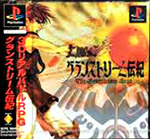 Finally, another game is worth mentioning here. After the release of Terranigma,
Kōji Yokata (graphic designer on Actraiser, Robotrek, Illusion of Gaia and Soul Blader)
apparently left Quintet to form his own video game studio called Shade.
He brought with him Tomoyoshi Miyazaki and released Grandstream Denki (aka The Granstream Saga)
for the Playstation in 1997 (picture on the right). It was the last game published by Quintet and
it interestingly shared a lot in common with Soul Blader, Illusion of Gaia and
Terranigma! If you are fan of the series then I would really advise you to check it out!
Finally, another game is worth mentioning here. After the release of Terranigma,
Kōji Yokata (graphic designer on Actraiser, Robotrek, Illusion of Gaia and Soul Blader)
apparently left Quintet to form his own video game studio called Shade.
He brought with him Tomoyoshi Miyazaki and released Grandstream Denki (aka The Granstream Saga)
for the Playstation in 1997 (picture on the right). It was the last game published by Quintet and
it interestingly shared a lot in common with Soul Blader, Illusion of Gaia and
Terranigma! If you are fan of the series then I would really advise you to check it out!
|
Teaser text from the American version:
Money. The root of all evil...
King Magridd sold out.
Obsessed with the desire of wealth, he cut a
dastardly deal with the ruler of evil. Now the Freil
Empire is in shambles and you are chosen to
save it. Free the Kingdom's captive souls. Teach
the King a thing or two about integrity. Rescue a
beautiful maiden. Liberate an imprisoned
inventor.
You'll boldly traverse six complex stages in
this action-RPG. An array of weapons, armor and
magic are at your disposal. After you revive the
kingdom, you will confront Deathtoll. Then, make
him pay...
|
Game Staff (Copied from the end credits) :
|
The Staff of SoulBlader
Scenario written by
Tomoyoshi Miyazaki
Programmed by
Masaya Hashimoto
Graphics designed by
Kouji Yokota
Masahiko Takai
Takeshi Matsumuro
Shintaro Majima
Music composed by
Yukihide Takekawa
Music arranged by
KAZZ TOYAMA
|
Sound Created by
You Himeno
Music Coordinated by
AMENITY Co.Ltd
Scenario Assistant
Tatsuo Hashimoto
Quintet Staff
Reiko Takebayashi
Akira Kitanohara
ENIX staff
Takao Kawaguchi
Keizo Mochizuki
Teruhiko Hanawa
Tetsuro Shimoda
Masahiko Hirasawa
Kenjiro Kano
Yasuko Sekiguchi
Miwako Matsumoto
Keiko Taga
|
|
Special Thanks
Ryuichi Moriya
Naoki Yasuda
Yoshiaki Ujiie
Shinichi Kouda
Taiki Mochida
Masahiro Endo
Azumi Izumi
Dai Yamamoto
Keiko Hattori
Nobuyoshi Yoshii
Miki Watanabe
Assistant producer
Kazunori Takado
Directed by
Masaya Hashimoto
|
|
Produced by
Yasuyuki Sone
Published by
Yasuhiro Fukushima
Copyright
© 1992 Quintet
© 1992 Yukihide Takekawa
© 1992 KAZZ TOYAMA
© 1992 AMENITY Co.Ltd
© 1992 ENIX
Presented by ENIX
|
|
Game Staff (Copied from the American version's end credits) :
|
The Staff of Soul Blazer
Scenario written by
Tomoyoshi Miyazaki
Programmed by
Masaya Hashimoto
Graphics designed by
Kouji Yokota
Masahiko Takai
Takeshi Matsumuro
Shintaro Majima
Music composed by
Yukihide Takekawa
Music arranged by
KAZZ TOYAMA
Sound created by
You Himeno
Music coordinated by
AMENITY Co.
Scenario assistant
Tatsuo Hashimoto
|
English Text by
Robert L.Jerauld
Quintet Staff
Reiko Takebayashi
Akira Kitanohara
ENIX staff
Takao Kawaguchi
Keizo Mochizuki
Teruhiko Hanawa
Tetsuro Shimoda
Masahiko Hirasawa
Kenjiro Kano
Yasuko Sekiguchi
Miwako Matsumoto
Keiko Taga
Hajime Kanie
Eiichi Hirasawa
Shinji Futami
ENIX America staff
Keiji Honda
Tsuneo Morita
Paul Bowler
Paul Handelman
Cherie Hasson
|
|
Special thanks to
Ryuichi Moriya
Naoki Yasuda
Yoshiaki Ujiie
Shinichi Kouda
Taiki Mochida
Masahiro Endo
Azumi Izumi
Dai Yamamoto
Keiko Hattori
Nobuyoshi Yoshii
Miki Watanabe
Hirotomo Morisada
Assistant producer
Kazunori Takado
Directed by
Masaya Hashimoto
Produced by
Yasuyuki Sone
Published by
Yasuhiro Fukushima
|
|
Soul Blazer
Copyright © 1992
© 1992 ENIX COPORATION
© 1992 Quintet
Based Upon Soul Blader
Copyright © 1992
© 1992 ENIX COPORATION
© 1992 Quintet
Music Copyright © 1992
© 1992 Yukihide Takekawa
© 1992 KAZZ TOYAMA
© 1992 AMENITY Co.
Licensed by NINTENDO
Presented by ENIX
|
|
|
G
O
O
D
I
E
S
|
|
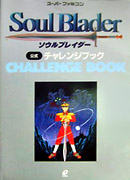
Japanese Guidebook
|
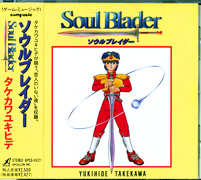
Japanese Soundtrack
|
|
|
O
M
A
K
E
|
|
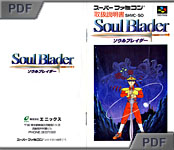
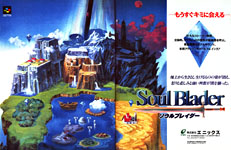
|
|
|
Click on picture to enlarge |
|
|
|
LK

|
|
Add your Pov here !
|
P
O
V
s
|
|
Soul Blader's presentation is fairly simple and not particularly
striking - sprites are rather small and their quality is arguably average.
At first sight, the game doesn't really stand out compared to other
masterpieces released at the time. But the more you play, the more you
realize how Soul Blader really shines. Although the game is
overall really easy and sometimes repetitive, Soul Blader is a
fantastic action RPG. It has unquestionable charms and incredible gameplay
mechanics. If you're a fan of Actraiser as I am, then
Soul Blader will delight you every step of the way. Although
it borrows a lot from its predecessor, Quintet managed to
carefully combine some of the gameplay mechanics that made
Actraiser so fun and ingeniously crafted a more traditional
RPG that oozes charm and atmosphere. Rebuilding the world as you
progress, reviving humans as well as friendly animals and learning
about their stories makes the game one long and incredibly satisfying journey.
All in all, I think that Soul Blader is a masterpiece that
doesn't squarely fit in any well-defined category. A must have!
|
|
|
|